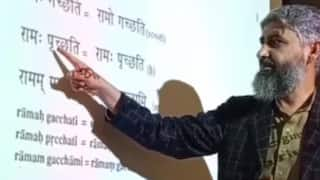Fossil Of Avian Skeleton Upends Century-Long Assumptions About Origin Of Modern Birds: Study
The new discovery suggests that the skulls of ostriches, emus and their relatives evolved "backwards". This means that these birds reverted to a more primitive condition after modern birds emerged.

Fossilised segments of a newly identified species of a large ancient bird have overturned century-long assumptions about the origins of modern birds. A team of researchers from University of Cambridge in England and Natuurhistorisch Museum Maastricht in Netherlands has uncovered new secrets about a mobile beak which evolved before the mass extinction event that killed all large dinosaurs, 66 million years ago. A mobile beak is one of the key skull features that characterises 99 per cent of modern birds.
This discovery suggests that the skulls of ostriches, emus and their relatives evolved "backwards". This means that these birds reverted to a more primitive condition after modern birds emerged.
The study describing these findings was recently published in the journal Nature. The research suggests that our understanding of how the modern bird skull evolved needs to be re-evaluated.
The new bird is called Janavis finalidens
The researchers from Cambridge University used computed tomography (CT) scanning techniques to identify bones from the palate of the newly identified species of a large ancient bird. The team named the bird Janavis finalidens.
Janavis was one of the last toothed birds to ever live
The bird lived at the very end of the Age of Dinosaurs, was one of the last toothed birds to ever live, and was a "dino-bird" with a mobile, dexterous beak. The break is almost indistinguishable from that of most modern birds.
It had been assumed for more than a century that the mechanism enabling a mobile beak evolved after the extinction of dinosaurs. But this is not the case, the new study reports.
Birds are divided into two groups based on palate bone arrangement
Based on the arrangement of the palate bones of the roughly 11,000 species of birds on Earth today, each is classified into one of two overarching groups. Ostriches, emus and their relatives belong to the palaeognath or "ancient jaw" group. This means that like humans, their palate bones are fused together into a solid mass.
The remaining birds are classified into the neognath, or "modern jaw group". This means that their palate bones are connected by a mobile joint. As a result, the beaks are much more dexterous, and helpful for grooming, defence, nest-building and food-gathering.
Early assumptions about bird jaws
Thomas Huxley, the British biologist who extended his vocal support to Charles Darwin's theory of evolution, and was known as "Darwin's Bulldog", had originally classified the two groups of birds. He divided all living birds into the two groups, namely ancient and modern jaw groups. He had assumed that the "ancient" jaw configuration was the original condition for modern birds, while the "modern" jaw configuration arose later.
In a statement released by University of Cambridge, Dr Daniel Field, the senior author on the paper, said the assumption has been taken as a given ever since, and the main reason this assumption has lasted is that researchers have not had any well-preserved fossil bird palates from the period when modern birds originated.
When was Janavis discovered?
The fossil of Janavis finalidens was discovered in a limestone quarry near the Belgian-Dutch border in the 1990s. First studied in 2002, the fossil dates back to 66.7 million years ago, during the last days of the dinosaurs.
In the early 2000s, scientists were able to base their descriptions only on what they could see from the outside because the fossil is encased in rock. Bits of bone were sticking out from the rock, which the researchers described as fragments of skull and shoulder bones. After that, researchers put the fossil back in storage.
How the new study was conducted
Almost 20 years later, the fossil was loaned to Dr Field's team from Cambridge's Department of Earth Sciences, and Dr Juan Benito, the lead author on the new paper, started analysing the remains.
Benito said researchers initially had high hopes for the fossil, which was originally said to have skull material. Skull material is not often preserved. Benito said researchers could not see anything that looked like it came from a skull in the CT scans. Hence, they gave up and put the fossil aside.
The fossil was a skull bone
Benito took the fossil out again during the early days of Covid-19 lockdown. He said that he had not been able to see how what was first described as a shoulder bone could actually be a shoulder bone.
Field said he could see the fossil was not a shoulder bone, but there was something familiar about it.
Benito added that the researchers realised they had seen a similar bone before, in a turkey skull, and since similar research is conducted in Cambridge, scientists happen to have things like turkey skulls in their labs. The team brought one turkey skull out and observed that the two bones were almost identical.
Modern jaw evolved before ancient jaw condition of ostriches
The researchers realised that the bone was a skull bone, and not a shoulder bone, and concluded that the unfused "modern jaw" condition, which turkeys share, evolved before the "ancient jaw" condition of ostriches and their relatives.
The study states that the fused palates of ostriches and their relatives must have evolved at some point after modern birds were already established, and the reason is unknown.
A toothless beak and a mobile upper jaw are two of the key characteristics which the researchers used to differentiate modern birds from their dinosaur ancestors.
Though Janavis is pre-modern, its jaw structure is modern
Janavis finalidens had teeth, making it a pre-modern bird. But its jaw structure is that of the modern, mobile kind.
Pei-Chen Kuo, a co-author on the paper, said the researchers were able to show that the shape of the fossil palate bone was extremely similar to those of living chickens and ducks.
Klara Widrig, another co-author on the paper, added that surprisingly, the bird palate bones that are the least similar to that of Janavis finalidens are from ostriches and their kin.
New study changed century-long assumptions about modern birds
Field said that evolution does not happen in a straight line, and this fossil shows that the mobile beak, which is a condition researchers had always thought post-dated the origin of modern birds, actually evolved before modern birds existed. He explained that researchers had been completely backwards in their assumptions of how the modern bird skull evolved for well over a century.
According to the researchers, the discovery does not mean that one needs to redraw the entire bird family tree, but upends one's understanding of a key evolutionary feature of modern birds.
What happened to Janavis finalidens?
Similar to large dinosaurs and other toothed birds, Janavis finalidens did not survive the mass extinction event at the end of the Cretaceous Period. According to the study, this may have been because of the bird's large size. It weighed around 1.5 kilograms and was the size of a modern vulture. "Wonderchicken" came from the same area as Janavis finalidens and lived alongside it, and was one of the smaller animals identified by Field, Benito and colleagues in 2020. Since wonderchicken had to eat less to survive, they had an advantage at that point in Earth's history. Though the asteroid that killed dinosaurs disrupted global food chains, wonderchicken and some other animals survived due to their small size.







































